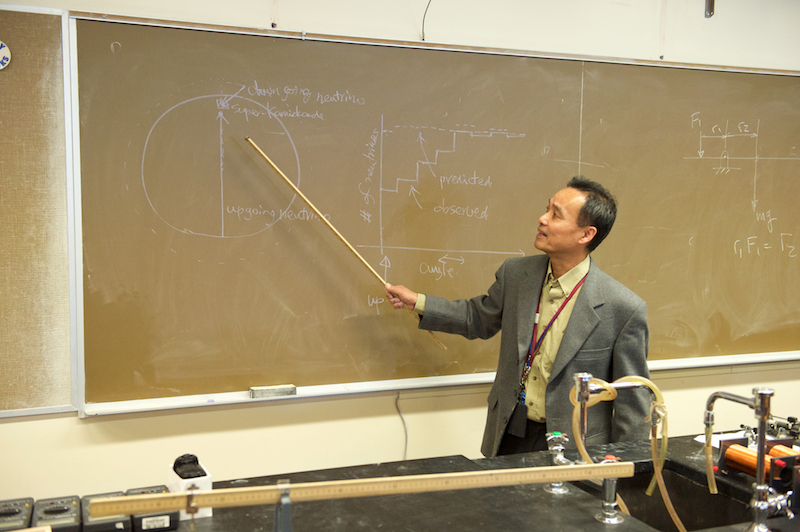
Since 1992, BMCC Professor of Science Chiaki Yanagisawa has been part of an international research team investigating neutrinos, sub-atomic particles rushing through space almost at the speed of light, and passing through matter, including our bodies, by the thousands of billions every second.
Yanagisawa, who joined the BMCC faculty in 2008, brings insights from the neutrino research project to his physics and astronomy classes at the college, and recently he had big news to share with students: His neutrino research team leader, Professor Takaaki Kajita of the University of Tokyo, Japan, along with Professor Arthur McDonald of Queen’s University, Canada, just received the 2015 Nobel Prize for Physics for proving that neutrinos oscillate, and change in identity — thus proving they have mass.
Research goes underground
As part of the neutrino research team, Professor Yanagisawa has spent years traveling back and forth to a sophisticated facility, Super-Kamiokande, built 1,000 meters beneath the surface of the earth in a zinc mine northwest of Tokyo.
Super-Kamiokande contains a tank filled with 50,000 tons of water, Yanagisawa explains, and neutrinos pass through, interacting with more than 11,000 light beams. In the process, they often change in “flavor,” a component of their identity, and this change led to the critical observation that they have mass.
Being part of Ajita’s neutrino research team is not the first time Yanagisawa has worked alongside a Nobel Prize-winning colleague. He was also part of a team that built the Kamiokande detector which preceded Super-Kamiokande, and was led by Professor Masatoshi Koshiba, who went on to win the Nobel Prize for Physics in 2002.
Yanagisawa adds that he and a colleague, Chang Kee Jung of Stony Brook University, were the first physicists in the United States to work with the late Professor Totsuka of the University of Tokyo, who spearheaded the building of Super-Kamiokande.
Giving students a glimpse of cutting-edge particle research
“Since I was a child, I wanted to be a mathematician or physicist,” says Yanagisawa, citing an early influence, the first Japanese Nobel laureate, Hideki Yukawa, a theoretical physicist who won the Nobel Prize in Physics in 1949.
In every class Yanagisawa teaches at BMCC, “I have a few students who have the potential and interest to pursue a science career,” he says. To give them a taste of what cutting-edge particle research entails, he provides C++ (a system programming language) text-file versions of binary data generated at the Super-Kamiokande facility.
“Students look for patterns in the digitized data,” he says. “We have to pick up the rare events, incidents containing some record of how many and what kind of particles there are. They could be examining over 2,000 lines of code, and they are beginning to understand particle identity, energy and its direction.”
Why neutrinos matter
To many, Yanagisawa admits, the relevance of deciphering the universe’s smallest known particles might not be apparent.
He is quick to point out though, that “You never know when you will discover something unexpected, which might be useful. Also, along the way, we develop new technologies, For example, the particle accelerator we use in our research is now used for cancer treatment. A lot of the by-products of inventions created during research are incredibly useful in society.”
He adds that when scientists discovered electrons in the 19th century, no one understood their potential use, “but now in everyday life we can’t get by without them; they exist in radio waves, x rays and ultraviolet light. So, my hope is that someday we will know the importance of neutrinos, as well.”

